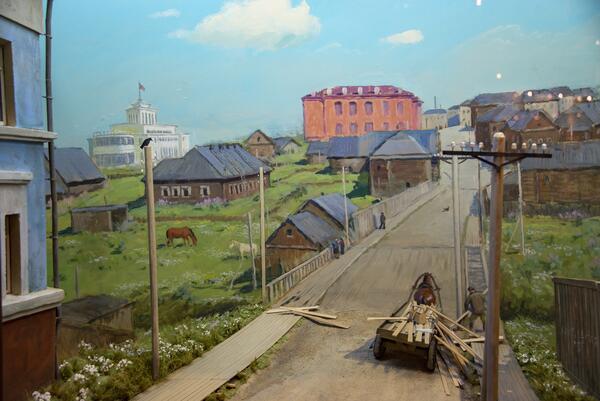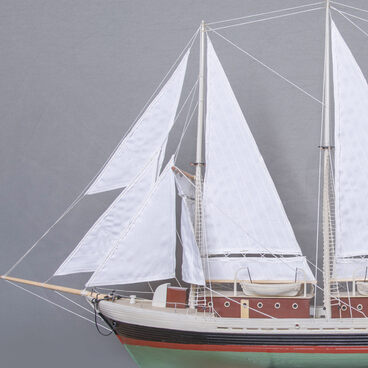In the 1950s, Dudinka used to be called the “chamomile town beyond the polar circle” for the abundance of these flowers.
However, the mini-diorama, which simulates a view from a window, shows more than just chamomiles and cozy wooden pavements. The central part of the canvas is taken up by the infamous historic bridge.
Locals call it the “Bridge of Memory”, and among museum staff, it is known by the name of Vladimir Bering. It was this bridge, built during the times of the Gulag, that each and every inmate of the Norilsk labor camp crossed.
Since the 1980s, the staff of the Taimyr Local History Museum has been researching the subject of repressions, which affected the lives of many worthy people. The life story of Vladimir Mikhailovich (von) Bering occupies a special place among those biographies.
A direct descendant of Captain-Commander Vitus Jonassen von Bering, who led the Great Northern Expedition and explored the shores of the Arctic, he was born in Yekaterinburg. He studied in Riga and later in Askhabad; in 1917, he became a volunteer Red Army soldier. Having graduated from the faculty of ballistics at the Artillery Academy of the Red Army, Vladimir Mikhailovich supervised the development of guns, which were used on most of the ships of the Soviet Navy. In 1933, he received the Order of the Red Star in February but in August he was accused of the leadership of a “saboteur group” and arrested. The capital punishment he was initially sentenced to was replaced by ten years in a Siberian labor camp. That is how the military engineer got to Dudinka and started working as a mechanical engineer within the system of Norilskstroy. In 1937, he was charged with the same offense and sentenced to capital punishment.
20 years later, the military engineer Bering was fully rehabilitated for lack of evidence.
Vladimir Bering’s fate was traced from the Book of Memory of the Victims of Political Repressions in the Krasnoyarsk Territory. Archive research, correspondence, and meetings made it possible to find his daughter, Marina Vladimirovna Bering. At the time of her father’s arrest she was only three years old. For years she searched for a place where she could pay homage to his memory, but there are no surviving camp burials in Dudinka. The only memorial place left is the bridge over the Aromatny brook on Dudinka’s main street.
However, the mini-diorama, which simulates a view from a window, shows more than just chamomiles and cozy wooden pavements. The central part of the canvas is taken up by the infamous historic bridge.
Locals call it the “Bridge of Memory”, and among museum staff, it is known by the name of Vladimir Bering. It was this bridge, built during the times of the Gulag, that each and every inmate of the Norilsk labor camp crossed.
Since the 1980s, the staff of the Taimyr Local History Museum has been researching the subject of repressions, which affected the lives of many worthy people. The life story of Vladimir Mikhailovich (von) Bering occupies a special place among those biographies.
A direct descendant of Captain-Commander Vitus Jonassen von Bering, who led the Great Northern Expedition and explored the shores of the Arctic, he was born in Yekaterinburg. He studied in Riga and later in Askhabad; in 1917, he became a volunteer Red Army soldier. Having graduated from the faculty of ballistics at the Artillery Academy of the Red Army, Vladimir Mikhailovich supervised the development of guns, which were used on most of the ships of the Soviet Navy. In 1933, he received the Order of the Red Star in February but in August he was accused of the leadership of a “saboteur group” and arrested. The capital punishment he was initially sentenced to was replaced by ten years in a Siberian labor camp. That is how the military engineer got to Dudinka and started working as a mechanical engineer within the system of Norilskstroy. In 1937, he was charged with the same offense and sentenced to capital punishment.
20 years later, the military engineer Bering was fully rehabilitated for lack of evidence.
Vladimir Bering’s fate was traced from the Book of Memory of the Victims of Political Repressions in the Krasnoyarsk Territory. Archive research, correspondence, and meetings made it possible to find his daughter, Marina Vladimirovna Bering. At the time of her father’s arrest she was only three years old. For years she searched for a place where she could pay homage to his memory, but there are no surviving camp burials in Dudinka. The only memorial place left is the bridge over the Aromatny brook on Dudinka’s main street.






